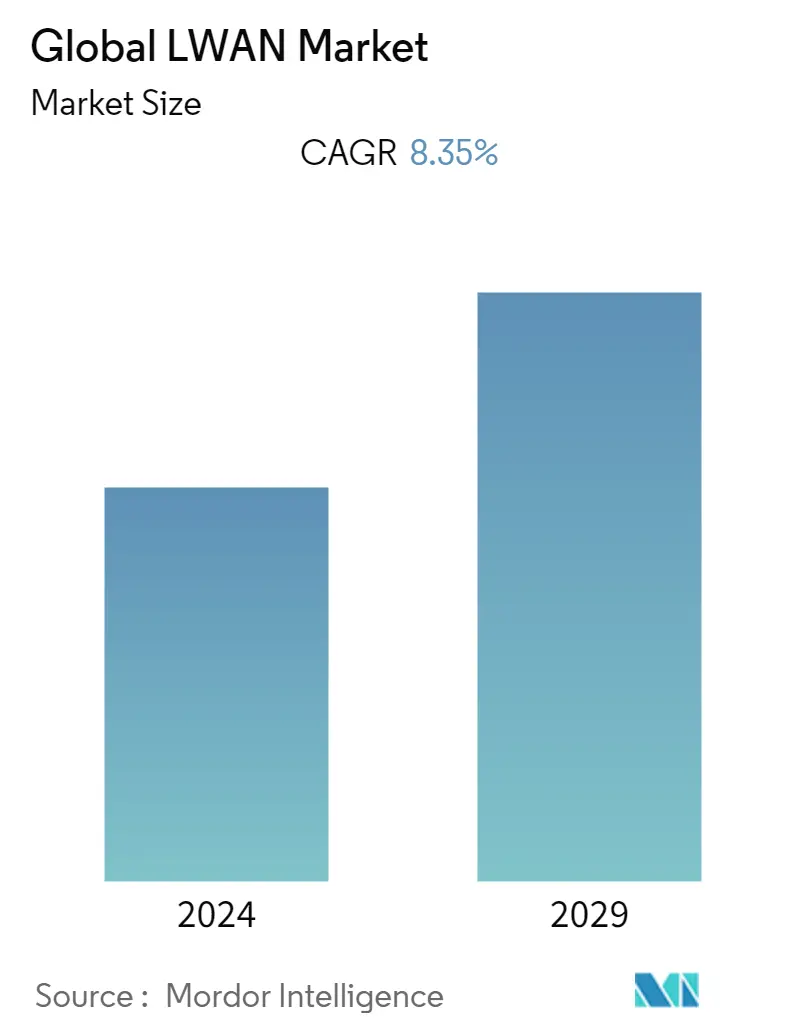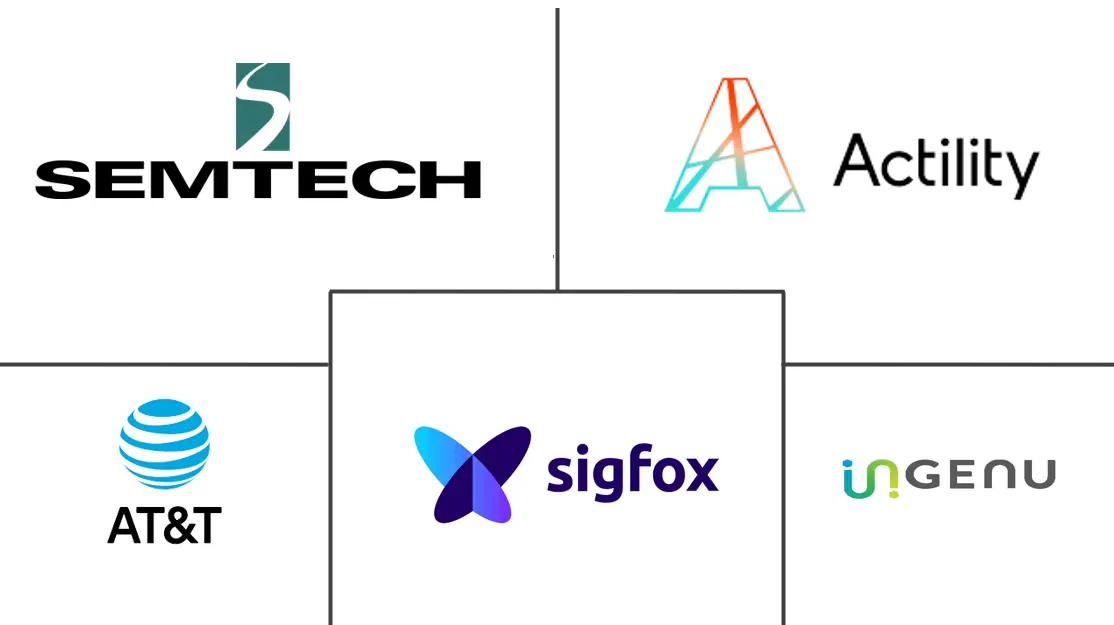Market Size of Global LWAN Industry

| Study Period | 2019 - 2029 |
| Base Year For Estimation | 2023 |
| CAGR | 8.35 % |
| Fastest Growing Market | Asia-Pacific |
| Largest Market | North America |
| Market Concentration | Medium |
Major Players
*Disclaimer: Major Players sorted in no particular order |
LWAN Market Analysis
The global LWAN market is expected to reach USD 1,275.06 billion by 2027, registering a CAGR of 8.35% during 2022-2027. The global low power wide area network (LWAN) market is growing at a fast rate owing to the increasing adoption of the Internet of things (IoT), machine-to-machine (M2M), and the rising need for long-range connectivity of devices.
- Low-Power Wide-Area Networks (LPWANs) are becoming one of the main building blocks for the Industrial IoT (IIoT) ecosystem, with most of the industries adopting Industry 4.0 practices and an alternative to 2G/3G/4G cellular networks where long-range communication at light speed is needed by battery-powered sensors spread around the factory. Among the most promising approaches, SIGFOX is an ultra-narrow band technology that allows similar signal coverage to cellular networks at one-thousandth of its power requirements.
- With the environmental changes, businesses are investing highly in smart city development, which is expected to play an important role in IoT adoption. Global Smart Cities Primer Picks, Bank of America Merrill Lynch (BAML) anticipates smart city technology and management investment to reach more than USD 3.48 trillion by 2026 globally.
- Increasing roll-outs in many parts of the world are driving the growth of the LPWAN industry. For instance, on March 15, 2022, The LoRa Alliance, the global association of companies backing the open LoRaWAN standard for the internet of things (IoT) low-power wide-area networks (LPWANs), announced significant market traction across France and Spain. LoRaWAN is already one of the preferred global choices for LPWAN, with more than 225 million LoRa/LoRaWAN end nodes.
- For the last two years, the COVID-19 pandemic has continued to impact many industries of the world as the infection spreads through person-to-person contact. Transmission and prognosis, once infected, are potentially influenced by many factors. Particulate Matter (PM) is a complex mixture of solid and/or liquid particles suspended in the air that can vary in shape, size, and composition, and recent scientific work correlate this index with a considerable risk of COVID-19 infections.
- The Internet of Things (IoT) and Early Warning Systems (EWS) have given rise to the development of Low Power Wide Area Networks (LPWAN) based on sensors, which monitor In-door Air pollution Quality (IAQ) and measure PM levels in real-time. The COVID-19 pandemic had led to the implementation of lockdown regulations across several nations resulting in disruptions in export and import activities of Enterprise LPWAN.
- Few of the challenges to this technology that may hamper the overall adoption and market include the cost of changing legacy equipment, future coverage and scalability, technology co-existence, and real-time communication. In addition, the network's security, not as robust as sending data back to endpoints, can also be prone to interference.
LWAN Industry Segmentation
Low-power wide-area networks(LPWAN) Or low-PowerWide-Area(LPWA) networks are wireless communication technologies designed for low data-rate, power-efficient communication over long distances at a low cost. The Global LWAN Market is segmented by Network Type (LTE-M, NB-IoT, Sigfox, and LoRa) End User (Utilities, Smart City, Consumer/Smart Homes, Industrial and Transportation, and Logistics), and Geography.
| By Network Type | |
| LTE-M | |
| NB-IoT | |
| Sigfox | |
| LoRa | |
| Other Technologies |
| End-User | |
| Utilities | |
| Smart City | |
| Consumer/Smart Homes | |
| Industrial | |
| Transportation and Logistics | |
| Other End-users |
| By Region | |
| North America | |
| Europe | |
| Asia-Pacific | |
| Rest of the World |
Global LWAN Market Size Summary
The global Low Power Wide Area Network (LWAN) market is experiencing rapid growth, driven by the increasing adoption of Internet of Things (IoT) and machine-to-machine (M2M) technologies, alongside the rising demand for long-range connectivity solutions. LWANs are becoming integral to the Industrial IoT ecosystem, particularly as industries transition to Industry 4.0 practices. These networks serve as a viable alternative to traditional cellular networks, offering efficient communication for battery-powered sensors across extensive areas. Technologies like SIGFOX and LoRaWAN are gaining traction, providing extensive coverage with minimal power requirements. The push towards smart city development further propels market expansion, as cities worldwide invest in IoT-enabled infrastructure to enhance urban living and operational efficiency.
The market landscape is moderately fragmented, with key players such as MachineQ, Sigfox SA, AT&T Inc., and Semtech Corporation actively participating in technological advancements and strategic partnerships. These collaborations aim to enhance IoT solutions and support the digital transformation of various sectors, including healthcare, transportation, and utilities. Despite challenges like legacy equipment costs and network security concerns, the LWAN market is poised for significant growth, supported by government initiatives and private sector investments in smart city projects. The Asia Pacific region, in particular, is witnessing substantial market share due to rapid industrialization and the adoption of Industry 4.0 technologies.
Global LWAN Market Size - Table of Contents
-
1. MARKET DYNAMICS
-
1.1 Market Drivers
-
1.1.1 Increasing Network Rollouts
-
1.1.2 Digital Transformation and Industry 4.0 Practices
-
-
1.2 Market Challenges
-
1.2.1 Legacy Equipment Across Industries is a Major Barrier to Adopting IoT
-
-
-
2. MARKET SEGMENTATION
-
2.1 By Network Type
-
2.1.1 LTE-M
-
2.1.2 NB-IoT
-
2.1.3 Sigfox
-
2.1.4 LoRa
-
2.1.5 Other Technologies
-
-
2.2 End-User
-
2.2.1 Utilities
-
2.2.2 Smart City
-
2.2.3 Consumer/Smart Homes
-
2.2.4 Industrial
-
2.2.5 Transportation and Logistics
-
2.2.6 Other End-users
-
-
2.3 By Region
-
2.3.1 North America
-
2.3.2 Europe
-
2.3.3 Asia-Pacific
-
2.3.4 Rest of the World
-
-
Global LWAN Market Size FAQs
What is the current Global LWAN Market size?
The Global LWAN Market is projected to register a CAGR of 8.35% during the forecast period (2024-2029)
Who are the key players in Global LWAN Market?
Sigfox, Semtech Corporation, Ingenu In., AT&T and ActilityS.A are the major companies operating in the Global LWAN Market.

